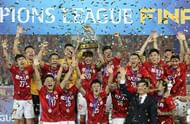The Chinese Super League (CSL) has in recent times emerged to become one of the biggest players on the world football stage.
Chinese President Xi Jinping is seeking to create a huge sports economy to out-rival any other world nation, with football at its heart. With incredible investment being made by both the government and businesses towards Xi’s aim, and none of the Financial Fair Play (FFP) rules that affect European clubs, Chinese teams are free to spend unhindered. Hence, they are able to provide astronomical wages, and can afford to pay out large transfer fees to acquire top talent. With many big names heading to the Orient from top European clubs, the profile of the CSL is rising.
What is behind the rise in Chinese football? How good actually is the CSL? Who is plying their trade in the Far East? What is in store for the future?
What is behind the rise of the CSL?President Xi believed to be a keen football fan, has devised a 10-year plan, running from 2015-2025 to create a sports economy worth $850 billion, an amount which would by exceed any other country by far.
Football is ‘the global game’, but China currently only rank 81st in the current FIFA world rankings, languishing behind nations such as Burkina Faso, Uzbekistan, and Equatorial Guinea. The country wants to be respected globally within the international stage, as evidenced by Xi’s statement that he wanted China to host, and win, the World Cup in 15 years. To achieve this, investment has been encouraged in the entire spectrum of Chinese football - from the CSL to the grassroots of the game.
With the amount of money that is now being invested into the Presidents plan from the government and businesses, and a lucrative television deal worth a reported $1.3 billion over five years, there has been unprecedented amounts of money being spent on the Chinese Super League. With large companies investing heavily in purchasing clubs, who can then spend freely in the acquisition of top playing talent. During the 2016 transfer window, Chinese clubs spent over $300 million - more than any other country. In improving the CSL, by importing top foreign players and managers, it is believed that this, in turn, will help to improve the standard of the Chinese national team, to make them a force to be reckoned with in the future.
How many teams compete?16 teams feature in the CSL. The current league table (as of 1st July 2016) is as follows:
# | Team | MP | W | D | L | GF | GA | GD | Points |
|---|---|---|---|---|---|---|---|---|---|
1 | Guangzhou Evergrande Taobao | 15 | 11 | 3 | 1 | 30 | 7 | 23 | 36 |
2 | Hebei China Fortune | 15 | 9 | 3 | 3 | 22 | 15 | 7 | 30 |
3 | Jiangsu Suning | 15 | 8 | 5 | 2 | 20 | 11 | 9 | 29 |
4 | Shanghai SIPG | 15 | 6 | 6 | 3 | 21 | 12 | 9 | 24 |
5 | Shanghai Shenhua | 15 | 5 | 7 | 3 | 24 | 15 | 9 | 22 |
6 | Henan Jianye | 15 | 6 | 4 | 5 | 13 | 12 | 1 | 22 |
7 | Tianjin Teda | 15 | 5 | 6 | 4 | 17 | 19 | -2 | 21 |
8 | Beijing Guoan | 14 | 5 | 5 | 4 | 15 | 13 | 2 | 20 |
9 | Liaoning | 14 | 4 | 5 | 5 | 15 | 22 | -7 | 17 |
10 | Yanbian Funde | 15 | 4 | 4 | 7 | 16 | 18 | -2 | 16 |
11 | Guangzhou R&F | 15 | 4 | 4 | 7 | 13 | 20 | -7 | 16 |
12 | Chongqing Lifan | 15 | 3 | 6 | 6 | 15 | 20 | -5 | 15 |
13 | Shijiazhuang Ever Bright | 14 | 3 | 5 | 6 | 10 | 16 | -6 | 14 |
14 | Changchun Yatai | 15 | 3 | 4 | 8 | 11 | 23 | -12 | 13 |
15 | Hangzhou Greentown | 15 | 3 | 3 | 9 | 8 | 18 | -10 | 12 |
16 | Shandong Luneng Taishan | 14 | 2 | 4 | 8 | 13 | 22 | -9 | 10 |
Who are the title holders?

Guangzhou Evergrande Taobao are the reigning champions. They have won the title for the past five seasons, and as the current league leaders, very much on course to make it a sixth.
How many teams can qualify for Continental Football?
Four teams qualify for the Asian Champions League. The top three teams in the league, and the winners of the Chinese FA Cup. If the FA Cup winner already qualifies by virtue of their league position, the remaining place is allocated to the team in fourth place in the league.
How many teams are relegated?
The bottom two teams are relegated to China League One (also known as the Chinese Jia League).
When does the season run?
The CSL season runs from March to November, with each team playing 30 games.
How good is the CSL?
British-born, Hong Kong international Jack Sealy, who plays for Changchun Yatai, told the BBC World Service "The top teams in the league like Guangzhou Evergrande and Shanghai SIPG would fare quite well at the top of the (English) Championship, maybe even the Premier League. The rest would be Championship and below.”, continuing “The signings have definitely raised the profile”.
But what is certain is that with the financial power that Chinese teams have, they will continue to have the resources to lure top players to their clubs in the future, and with increased efforts to improve the grassroots of the game, the raising of the standard of the league should be ensured in the future.
What player restrictions do teams have?
CSL teams are restricted to a maximum of five foreign players to be registered in their squads, of which at least one of those players must be from the Asian Football Federation. No foreign goalkeepers are permitted to be registered, in order to improve the quality of home-grown players.
Outfield players who are from Hong Kong, Macau or Taiwan, who signed contracts before 1st January 2016, are considered ‘non-foreign’ and are not included in the teams’ foreign player restrictions. However, this only applies to three players in the league.
Because of the tight restrictions on foreign imports to the league, the ambitious teams with financial clout are constantly, and ruthlessly, trying to improve their sides. This can lead to overseas players’ contracts being terminated before they have expired. This is what happened to Australian international, and ex-Everton captain Tim Cahill, who was told by Shanghai Shenhua manager Gregorio Manzano that he was not in his plans for the 2016 season. Cahill, who then signed for Hangzhou Greentown, told the BBC its “like a revolving door”.
Who is plying their trade in the CSL?
With Chinese clubs willing to splash the cash for top players, paying large transfer fees, and offering incredible contracts to players, talented players are being lured to the Asian powerhouse. Over $300 million was spent in the 2016 transfer window alone. Now, the European transfer window is open, we can further expect big deals to come. One such deal is the arrival of Brazilian forward Hulk to Shanghai SIPG from Zenit St Petersburg for an Asian transfer record beating fee of £45m.
Here is a list of some of the most high-profile signings made in recent times, along with their reported transfer fees:
Player | From | To | Transfer Fee (£) |
|---|---|---|---|
Alex Teixeira | Shakhtar Donetsk | Jiangsu Suning | £37.50m |
Jackson Martinez | Atlético Madrid | Guangzhou Evergrande Taobao | £31.50m |
Ramires | Chelsea | Jiangsu Suning | £21.00m |
Gervinho | AS Roma | Hebei China Fortune | £13.50m |
Demba Ba | Besiktas | Shanghai Shenhua | £9.75m |
Fredy Guarin | Inter | Shanghai Shenhua | £9.75m |
Renato Augusto | Corinthians | Beijing Guoan | £6.00m |
Paulinho | Tottenham | Guangzhou Evergrande Taobao | £10.50m |
Asamoah Gyan | Al-Ain | Shanghai SIPG | £6.75m |
Ezequiel Lavezzi | Paris Saint-Germain | Hebei China Fortune | £4.13m |
Gil | Corinthians | Shandong Luneng Taishan | £6.38m |
Elkeson | Guangzhou Evergrande Taobao | Shanghai SIPG | £13.88m |
Stéphane Mbia | Trabzonspor | Hebei China Fortune | £3.75m |
(Source: Transfermarkt) During the last transfer window, the Chinese transfer record was broken four times in one month. Indeed, it is believed that these names are only the start, and many more big names will be arriving in the future. Football agent Romain Woo insisted that top players will continue to flock to the country stating, somewhat arrogantly: "It's going crazy right now, it's really going crazy. We have a saying that the only two players who are not coming to China right now are Cristiano Ronaldo and Lionel Messi,"
But it’s not just foreign players in demand, some well-known managers have taken the reigns CSL clubs. Former Chelsea and Brazil boss Luiz Felipe Scolari (Guangzhou Evergrande Taobao), ex-England, Manchester City and Lazio manager Sven-Göran Eriksson (Shanghai SIPG) and experienced German coach Felix Magath (Shandong Luneng) have joined the Chinese football revolution.
What’s in store for the future? Can China become a world football superpower?As stated previously, President Xi wants to boost China’s sports economy and to host, and win, the World Cup in 15 years. Indeed, further to that, the Chinese FA revealed plans to become a ‘world football superpower’ by 2050.
With considerable investments to be made in the grassroots of the game, the CFA’s plans stated that by 2020, they aim to get 50 million people playing football, and to have around 90,000 training centres and pitches in place; eventually in the medium to long-term ensuring there is at least one football pitch for very 10,000 people. But this alone will not be enough, China must build a football culture, and as always there must be a continuing political will to maintain the levels of investment to achieve their goals.
“Ten years ahead, 15 years ahead, I am quite sure the China national team will compete to win the World Cup," Sven-Göran Eriksson told the BBC World Service. "The money is here and the football is getting better. I think attitudes have changed," he continued.
With considerable investment into all levels of the Chinese game, from the grassroots to the CSL, we should expect the standard of Chinese players to improve in the future. And with a continuing flow of top foreign players and coaches arriving on Chinese shores, the CSL will become more and more competitive, and maybe will be a world-beater in the coming years and decades.

